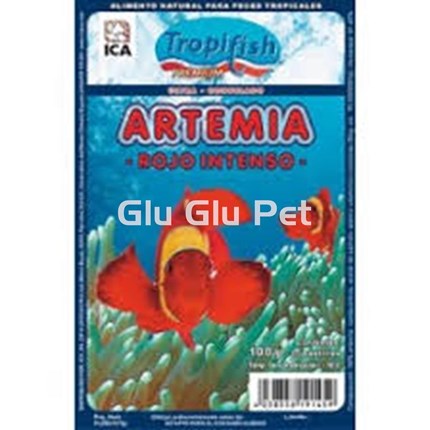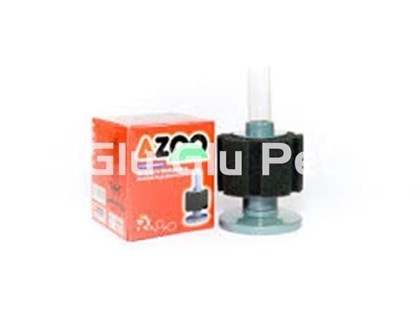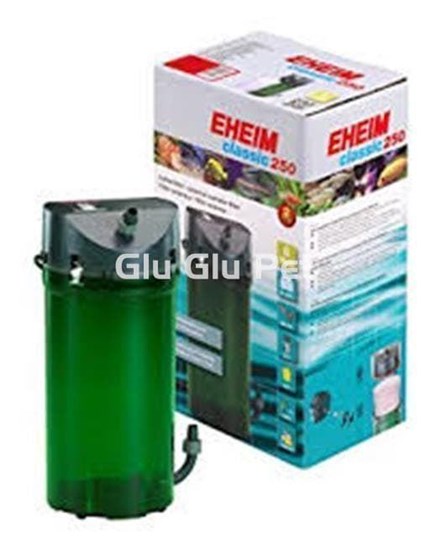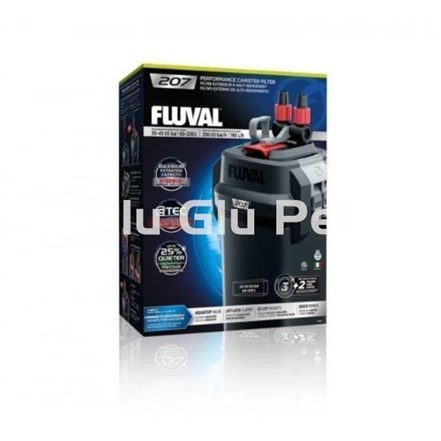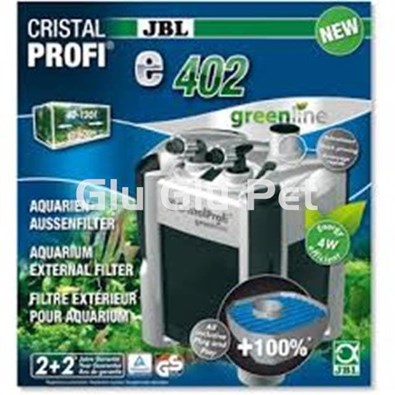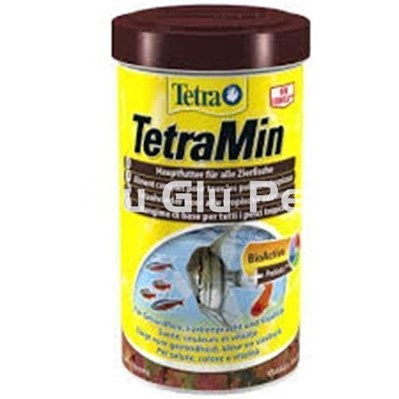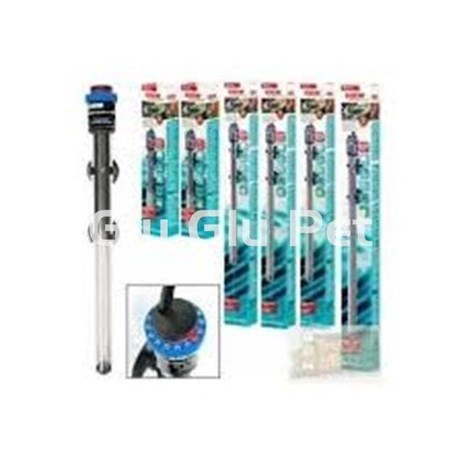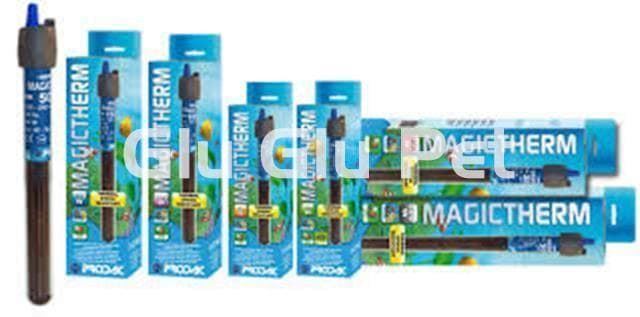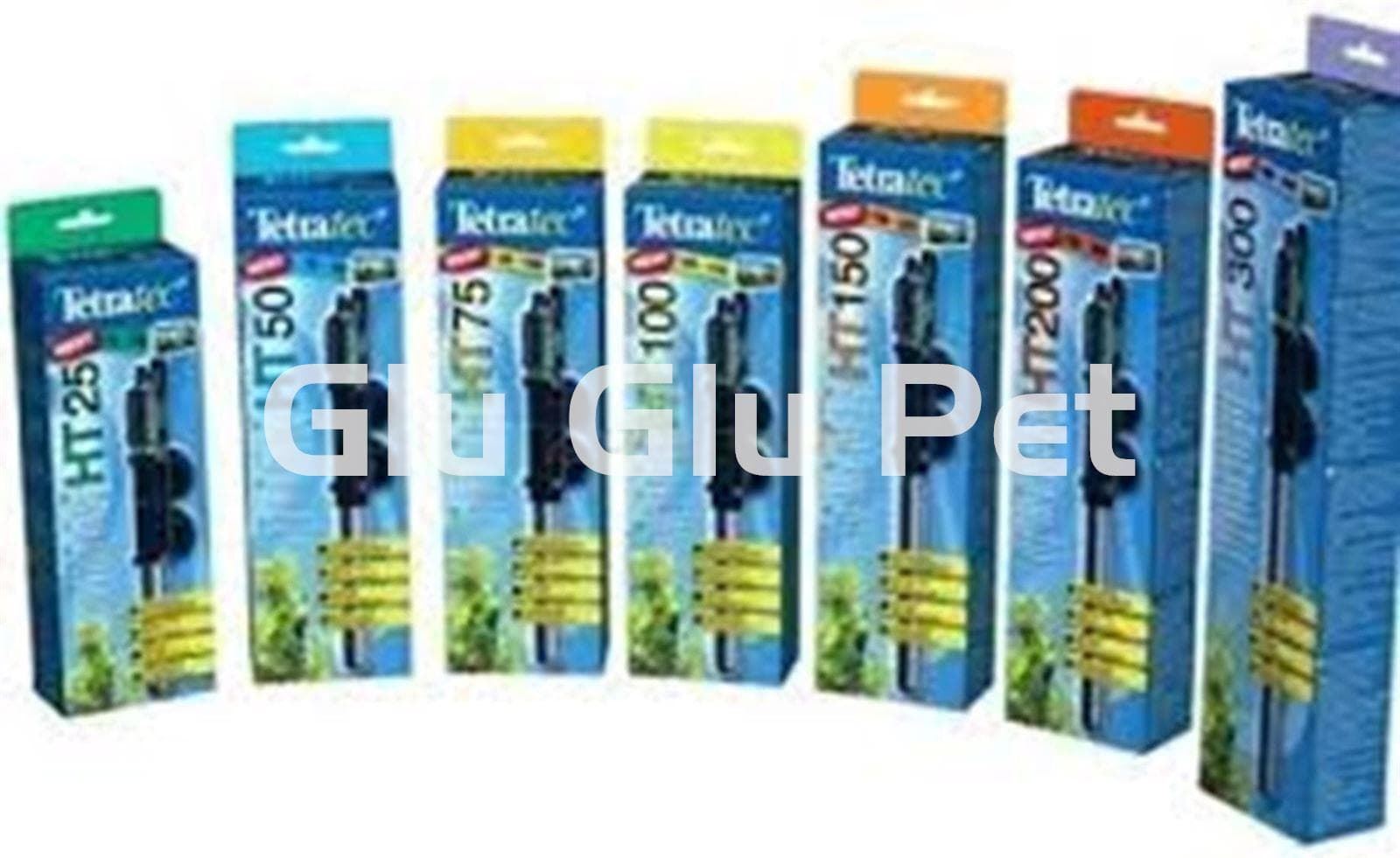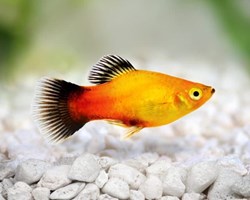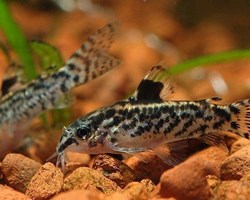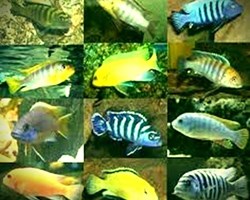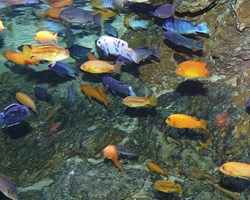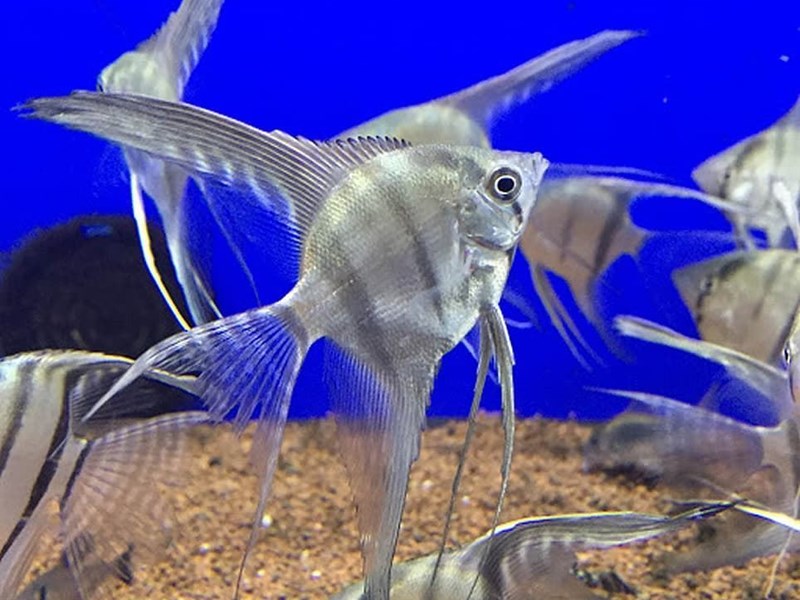
The scalar, or angel fish is one of the kings of our aquariums.
It is one of those fish that attract all eyes in an aquarium due to its elegance and its characteristic shape.
At Glu Glu Pet we are going to explain the different guidelines to keep in mind to keep the scalars in the best possible conditions and enjoy one of the most reputable fish in freshwater aquariums to the fullest.
DESCRIPTION OF THE SCALAR FISH OR PTEROPHYLLUM SCALARE:
With the Escalar or "angel fish" we find ourselves before one of the best known fish within the aquarophile.
Climbing is the reason for initiation of many fans since with its smooth movements and its figure suspended in the middle of an aquarium, it transmits the serenity and harmony that characterizes the aquarium hobby.
In terms of taxonomy, we have three varieties within the same species: pterophyllum scalare, altum or leopoldi, focusing in this case on the first of them, the scalare.
Regarding the physiognomy, it has a laterally flattened body and notorious dorsal and anal fins that prevail over the rest, the ventral ones.
These fins, almost filiform, extend to the height of the anal fin or somewhat less.
In its wild state, it is grayish green with silver reflections, 4 vertical dark stripes, in its adult state (7 in juveniles), whose greater or lesser coloration will depend on the mood of the scalar.
When there has been some type of confrontation in an aquarium with a school of scalars, we will see some very marked stripes as it is one of the symptoms that appear when they make their great character known to the rest.
The size is between 14-16 cm, from mouth to tail, without varying from male to female in height.
It can reach 20-22 cm in height.
The largest species is the scalar altum that exceeds 30 centimeters in height and requires aquariums with a water column greater than 60-70 centimeters.
Most were governed by the following rules:
- The male has a pronounced bulge on his forehead and the female does not.
- The male has a crest at the beginning of his dorsal fin.
- Males have less difference between the ventral and anal fin.
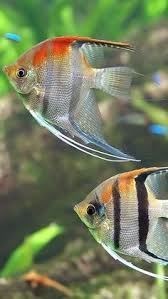
GEOGRAPHICAL DISTRIBUTION:
We find them in South America, along the Amazon basin and its respective tributaries.
Depending on the biotope or area in which the pterophyllum scalare is found, it shows a coloration and adaptation to the environment, emerging subspecies, since its care is more demanding than the common scalar.
The scalar, in its natural habitat, is found among the branches and leaves of the riverbanks, hidden on the lookout for its prey or defending its eggs.
Normally in calm waters and characterized by an amber color due to the large presence of tannins due to the decomposition of leaves, branches, seeds, etc.

VARIETIES OF SCALAR FISH:
Most of the scalars that we can find in stores come from a genetic selection of pterophyllum scalare, through which new lines have been defined over time.
Most, if not all, of the species listed below are not found in the wild.
In this way, the most common scalars are the following:
- Silver.
- Albino.
- Koy.
- Gold.
- Smokey.
- Black.
- Pinoy.
- Leopard.
- Marble.
- Ghost.
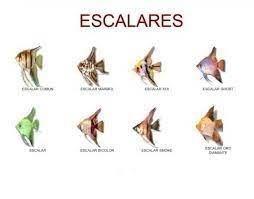
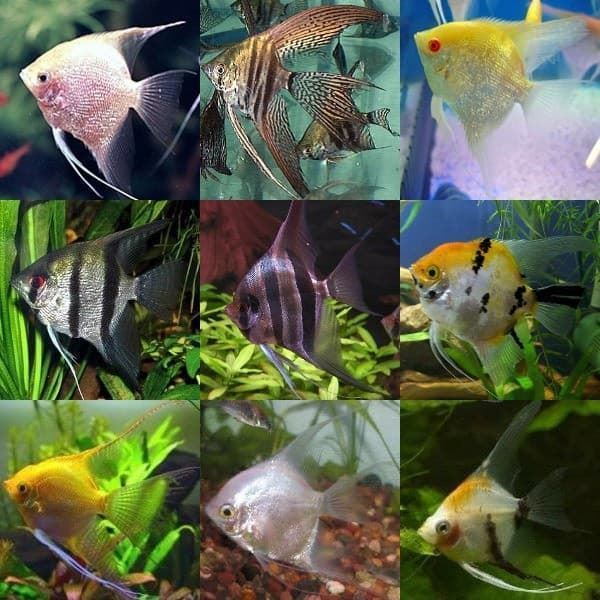
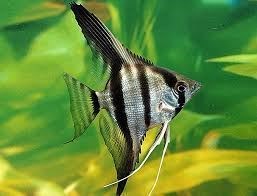
Climb silver.
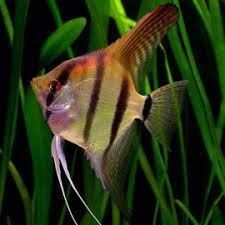
Climb zebra.
SCALAR FISH NUTRITION:
We can feed it with a wide variety of dry food, although due to its protein preference, we should often feed it with brine shrimp, red or black mosquito larva, tubifex, etc.
It is also advisable to provide dry vegetable food as this improves the color.
RECOMMENDED AQUARIUM FOR SCALAR FISH:
We are facing a fish that requires an aquarium of a certain size, since, being gregarious fish, they need to be in a group.
The aquarium must be a minimum of 200 liters to maintain a group of scalars that establish their hierarchy properly.
Although it seems like a calm fish, it can bring out its character at any time.
we must guarantee enough space for them to have shelter to hide if they require it.
They can be in planted aquariums, although their ideal aquarium is with a multitude of trunks and branches in which they can hide, broad-leaved plants such as echinodorus or anubias where they may be encouraged to spawn.
The presence of tannins in the water is highly recommended, since in their natural habitat they are found in most cases in black water.
We can get them with certain types of wood (mopani, mangrove, etc), dry leaves, alder cones, and in Glu Glu Pet.
The substrate is indifferent although they look better in sand since it better recreates their natural environment.
Finally, in terms of filtration, it is necessary that it be very efficient both biologically and mechanically, since it is a large fish that produces abundant waste. Thus, we recommend that the filtration be oversized compared to the volume of the aquarium.
At Glu Glu Pet we recommend that if you want a school of scalars that will accompany you during a long stage of your life, it is best to put them from a very young age in at least 200 liters and with a guaranteed future.
When we separate the scalars, they come from a hierarchy and introduce them with another or separate them from "their herd", it can cause stress that shortens their life span or makes it difficult for them to feed properly.
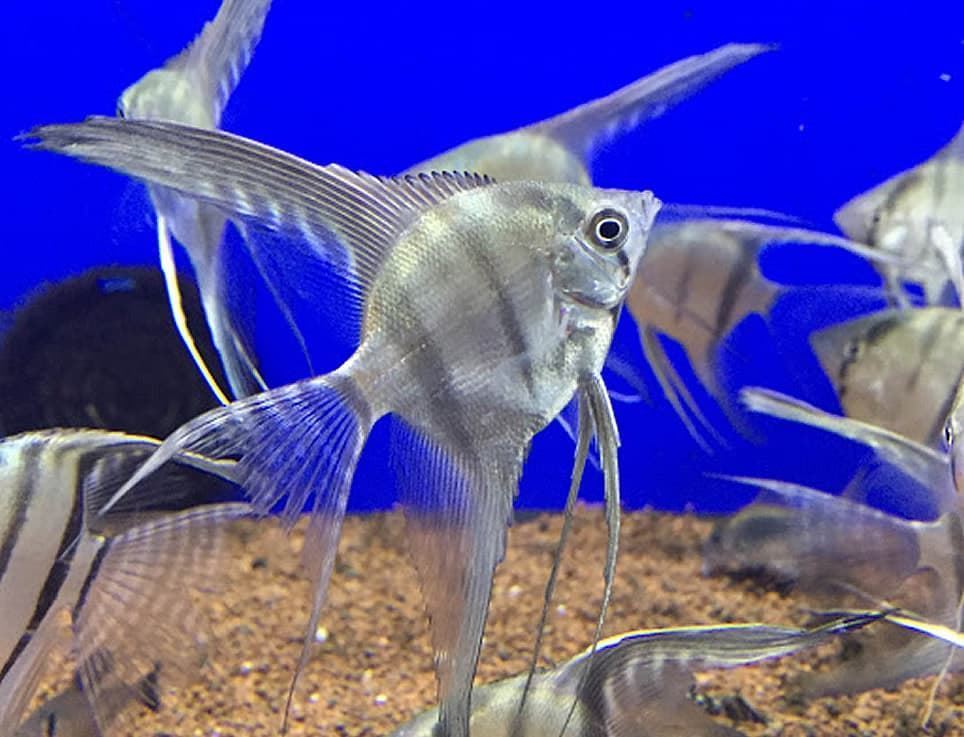
IDEAL WATER PARAMETERS FOR SCALAR FISH:
Even if it is a "resistant" fish, it is important to give them the ideal conditions because if not, it is more susceptible to getting sick.
It is a resistant fish as long as it is in its ideal conditions:
- Temperature: 25-26ºC
- Ph: 6.5-7.
- Kh: 2-3.
- Gh: Around 10.
- Water free of nitrogenous compounds.
- Scalar compatibility with other species.
The scalar is a territorial and gregarious fish, so it should be kept in schools and in large aquariums.
The scalar, or angel fish, has a wide compatibility with the rest of the species.
We must take special care that none of its companions is so small that it enters the mouth of our scalars.
If so, they will not hesitate to devour them.
During the breeding season, the most common thing, like so many other species, is for the pair to become aggressive, defending their laying territory.
Our recommendation is to keep them with Amazonian species, as this way we ensure that they share the same water parameters.
In this way, our ideal aquarium for scalars, as long as the size of the aquarium allows it, would be with a school of corydoras and another of tetras, some loricariids and a couple of dwarf cichlids.
REPRODUCTION OF THE SCALAR FISH OR ANGEL FISH:
In order to reproduce this species without major problems, we must have a group of 5 or more scalars (we always recommend having an odd number of specimens as it greatly facilitates the establishment of the hierarchy).
Taking this into account, we will have no choice but to wait until a couple is formed.
Once we have a pair of adult scalars, it is best to separate them into an 80 to 150 liter aquarium (although we can also leave the pair in the normal aquarium and when they lay, we separate them and take care of them ourselves).
In community aquariums they require a lot of experience (the scalars) until they make a bet.
At the slightest threat they will eat it for fear of losing it and for others to eat it, because they eat it themselves.
If we separate the couple to a specific aquarium we have two options:
- Let the parents take care of the laying.
- Separate the eggs once laid to a smaller aquarium.
Firstly, most of the time they will lay on a wide leaf or flat stone.
Later, the parents themselves will be in charge of fanning the eggs (bear in mind that the clutches are very large, and can reach up to 300 eggs) until after 3-4 days they will hatch.
At this time the hatchlings will remain glued to the surface where they have spawned and after a couple of days we will see the hatchlings swimming freely.
These will be supervised by parents at all times.
NUTRITION OF THE FISH OF SCALAR FISH:
It will be necessary to feed the fry with nauplii of newly hatched brine shrimp.
We recommend starting the cultivation of artemia as soon as we see the start in the aquarium, regardless of whether it goes ahead or not.
As soon as we see a clutch, the first thing we do is hatch artemia.
In the event that the laying does not go ahead, the tricks, guppies, rasboras, etc. They can be considered very lucky.
More or less for a month they will require specific food for them.
Artemia nauplius, small grindal or vinegar eel is the best for our little ones to grow and develop perfectly.
As soon as they are large enough to eat dry food, which will be a month or so after the hatching of the eggs, we must separate the young and introduce them into a fattening aquarium.
Otherwise, the parents ignore their young and can even devour them.
If, on the other hand, we decide to remove the spawn from the parents from the first moment, we must separate the stone or leaf with the eggs into an aquarium (with the same water as the aquarium they come from) to which we will put aeration to prevent fungi from proliferating. in the eggs.
It is also convenient to take some antifungal, the most common is methylene blue.
We will change 10% of the water daily and wait for the hatchlings to swim freely to start feeding as indicated in the previous paragraphs.
To avoid having to move all the fry to a fattening aquarium, it is recommended that the aquarium where we bring the spawn is about 60 liters, because if we put them in 20 or 30, sooner or later we will have to move to one of higher liter with the stress that this entails in the little ones.
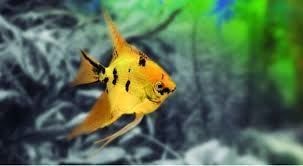
Glu Glu Pet products that may interest you:
- Anubia Barteri var. potted lullaby
- Anubia Nana in pot.
- Cryptocoryne Undulatus Green.
- TETRAMIN.
- TETRA weekend.
- AZOO PREMIUM RED LARVA 130ml.
- Frozen brine shrimp 20x5g.
- External filter: EHEIM CLASSIC 250/2213 (on offer).
- External filter: EHEIM CLASSIC 350/2215.
- External filter: EHEIM CLASSIC 600/2217.
- External filter: EHEIM PROFESSIONAL 4 250.
- External filter: EHEIM PROFESSIONAL 4 350.
- Fluval 207 External Filter.
- Fluval 307 External Filter.
- External filter: JBL Cristal profi e402.
- Breeding filter: AZOO BIO FILTER SPONGE FILTER.
- SPONGE FILTER FOR BREEDING.
- SEA-STAR THERMOHEATER 25W-300W.
- Tetratec HT heater.
- 25-300W Magicterm thermo-heaters (PRODAC).
- JAGER THERMOHEATERS 25W-300W (EHEIM).
- JBL THERMOMETER MINI.
- MINERVA LARGE ADHESIVE LIQUID CRYSTAL THERMOMETER (HAGEN).
- MARINE GLASS THERMOMETER WITH SUCTION CUP.
- PRODAC small adhesive digital thermometer.
- INDOOR DIGITAL THERMOMETER WITH SUCTION CUP.
- FLUVAL NANO THERMOMETER (HAGEN).
- Rock Amano Ryuoh.
- Rock Dragon.
- Volcanic rock.
- Dragon Rocks Set.
- Holestone Rocks Set.
- WOOD FROM MALAYSIA.
- MOPANI WOOD.
